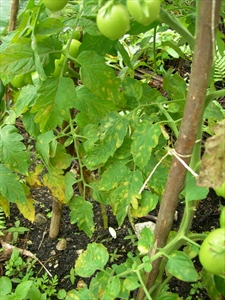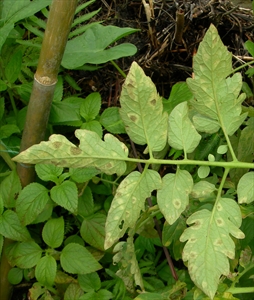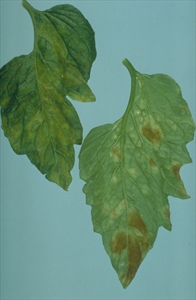Tomato leaf mould
Pacific Pests, Pathogens and Weeds - Online edition
Pacific Pests, Pathogens & Weeds
Tomato leaf mould (076)
Passalora fulva (previously known as Fulvia fulva, Mycovellosiella fulva and Cladosporium fulvum).
Asia, Africa, North, South and Central America, the Caribbean, Europe, Oceania. It is recorded from Australia, American Samoa, Fiji, French Polynesia, New Caledonia, New Zealand, Papua New Guinea, Samoa, Solomon Islands, and Tonga.
Tomato
Yellow spots and patches occur on the top surface of the leaves (Photo 1), with brown to green spore masses on the lower surface (Photos 2&3). The diseased areas join together and the leaves dry up and die.
Survival between crops occurs in a number of ways. The fungus survives as spores or as 'mycelium' (the cotton-like growth of the fungus) in dead tomato plants of the previous crop. It is spread as spores in air currents, by water splash, or on tools and clothing. There is a possibility that spread also occurs by insects and on seed.
The fungus causes a serious disease in cooler, wetter areas. The loss of leaves, from the bottom of the plant upwards, is rapid. Yield reduction is related to the time of infection. If plants are infected before fruits are formed, considerable crop loss occurs. In severe cases, the flowers and, occasionally, the fruit are attacked. Infected flowers may fail to set fruit. Occasionally, the fungus causes an internal blackening of the fruit.
Note, in Samoa, fruit yields of susceptible varieties were tripled when fungicides were used to control the disease.
In Solomon Islands, it is an important disease in the highlands. It is less common in coastal areas where another leaf mould disease occurs on tomatoes called black leaf mould, Pseudocercospora fuligena (see Fact Sheet no. 45).
Look for the yellow spots and rapidly developing irregular patches on the upper surfaces of the lower leaves, with brown to green areas on the under surface. Look for plants where leaves dry up and die rapidly.
Note, there is another disease that has similar symptoms. It is called tomato black leaf mould, caused by the fungus, Pseudocercospora fuligena (see Fact Sheet no. 45). This fungus and Passalora fulva can only be distinguished by looking at their spores under a microscope.
CULTURAL CONTROL
Before planting:
- Do not plant successive crops of tomatoes on the land or in the same garden; use a 3-year crop rotation.
- Do not plant new crops next to those that have the disease; otherwise spread of the disease to the new crop will be rapid and significant.
- It is not known for certain whether seed is important in the spread of the fungus. However, hot water treatment has been used as a method of producing seed free from contamination by fungal spores. Seed is treated with water for 25 minutes at exactly 50°C. Note, this is not a method that farmers would use, because of the need for a thermometer. Also, treatment of seed by this method would only be done as a last resort, after other methods have been tried and failed.
During growth:
- Remove infected lower leaves as soon as the first three or four fruit trusses (bunches) have been picked.
- Do not use overhead irrigation; otherwise, it will create conditions for spore production and infection.
After harvest:
- Collect plant remains and burn them, or dig them deeply into the soil.
RESISTANT VARIETIES
Leaf-mould resistant varieties are available. However, the fungus mutates readily (there are at least 12 races), and varieties may not be resistant to them all.
CHEMICAL CONTROL
The cool, wet, conditions in Pacific island countries favour the disease such that fungicides are needed to give adequate control. The products to use are chlorothalonil, copper oxychloride or mancozeb. Treatment should start when the yellow spots are first seen, and continue at 10-14-day intervals until 3-4 weeks before last harvest. It is important to spray both sides of the leaves.
____________________
When using a pesticide, always wear protective clothing and follow the instructions on the product label, such as dosage, timing of application, and pre-harvest interval. Recommendations will vary with the crop and system of cultivation. Expert advice on the most appropriate pesticide to use should always be sought from local agricultural authorities.
AUTHORS Helen Tsatsia & Grahame Jackson
Information from Leaf mould of tomato (2015) University of Minnesota Extension. (https://extension.umn.edu/diseases/leaf-mold-tomato); and CABI (2019) Passalora fulva (tomato leaf mould). Invasive Species Compendium. (https://www.cabi.org/ISC/datasheet/24580); and from Diseases of vegetable crops in Australia (2010). Editors, Denis Persley, et al. CSIRO Publishing. Photo 3 Kohler F, et al.(1997) Diseases of cultivated crops in Pacific Island countries. South Pacific Commission. Pirie Printers Pty Limited, Canberra, Australia.
Produced with support from the Australian Centre for International Agricultural Research under project PC/2010/090: Strengthening integrated crop management research in the Pacific Islands in support of sustainable intensification of high-value crop production, implemented by the University of Queensland and the Secretariat of the Pacific Community.






